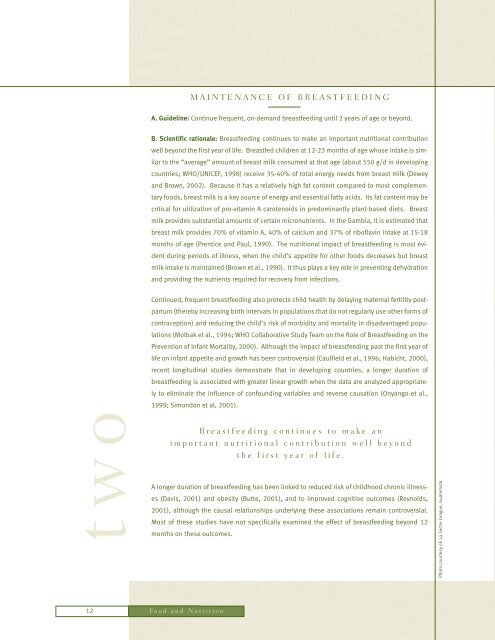Guiding Principles for Complementary Feeding of the Breastfed
Guiding Principles for Complementary Feeding of the Breastfed
Guiding Principles for Complementary Feeding of the Breastfed
Create successful ePaper yourself
Turn your PDF publications into a flip-book with our unique Google optimized e-Paper software.
two<br />
MAINTENANCE OF BREASTFEEDING<br />
A. Guideline: Continue frequent, on-demand breastfeeding until 2 years <strong>of</strong> age or beyond.<br />
B. Scientific rationale: Breastfeeding continues to make an important nutritional contribution<br />
well beyond <strong>the</strong> first year <strong>of</strong> life. <strong>Breastfed</strong> children at 12-23 months <strong>of</strong> age whose intake is similar<br />
to <strong>the</strong> “average” amount <strong>of</strong> breast milk consumed at that age (about 550 g/d in developing<br />
countries; WHO/UNICEF, 1998) receive 35-40% <strong>of</strong> total energy needs from breast milk (Dewey<br />
and Brown, 2002). Because it has a relatively high fat content compared to most complementary<br />
foods, breast milk is a key source <strong>of</strong> energy and essential fatty acids. Its fat content may be<br />
critical <strong>for</strong> utilization <strong>of</strong> pro-vitamin A carotenoids in predominantly plant-based diets. Breast<br />
milk provides substantial amounts <strong>of</strong> certain micronutrients. In <strong>the</strong> Gambia, it is estimated that<br />
breast milk provides 70% <strong>of</strong> vitamin A, 40% <strong>of</strong> calcium and 37% <strong>of</strong> rib<strong>of</strong>lavin intake at 15-18<br />
months <strong>of</strong> age (Prentice and Paul, 1990). The nutritional impact <strong>of</strong> breastfeeding is most evident<br />
during periods <strong>of</strong> illness, when <strong>the</strong> child’s appetite <strong>for</strong> o<strong>the</strong>r foods decreases but breast<br />
milk intake is maintained (Brown et al., 1990). It thus plays a key role in preventing dehydration<br />
and providing <strong>the</strong> nutrients required <strong>for</strong> recovery from infections.<br />
Continued, frequent breastfeeding also protects child health by delaying maternal fertility postpartum<br />
(<strong>the</strong>reby increasing birth intervals in populations that do not regularly use o<strong>the</strong>r <strong>for</strong>ms <strong>of</strong><br />
contraception) and reducing <strong>the</strong> child’s risk <strong>of</strong> morbidity and mortality in disadvantaged populations<br />
(Molbak et al., 1994; WHO Collaborative Study Team on <strong>the</strong> Role <strong>of</strong> Breastfeeding on <strong>the</strong><br />
Prevention <strong>of</strong> Infant Mortality, 2000). Although <strong>the</strong> impact <strong>of</strong> breastfeeding past <strong>the</strong> first year <strong>of</strong><br />
life on infant appetite and growth has been controversial (Caulfield et al., 1996; Habicht, 2000),<br />
recent longitudinal studies demonstrate that in developing countries, a longer duration <strong>of</strong><br />
breastfeeding is associated with greater linear growth when <strong>the</strong> data are analyzed appropriately<br />
to eliminate <strong>the</strong> influence <strong>of</strong> confounding variables and reverse causation (Onyango et al.,<br />
1999; Simondon et al, 2001).<br />
Breastfeeding continues to make an<br />
important nutritional contribution well beyond<br />
<strong>the</strong> first year <strong>of</strong> life.<br />
A longer duration <strong>of</strong> breastfeeding has been linked to reduced risk <strong>of</strong> childhood chronic illnesses<br />
(Davis, 2001) and obesity (Butte, 2001), and to improved cognitive outcomes (Reynolds,<br />
2001), although <strong>the</strong> causal relationships underlying <strong>the</strong>se associations remain controversial.<br />
Most <strong>of</strong> <strong>the</strong>se studies have not specifically examined <strong>the</strong> effect <strong>of</strong> breastfeeding beyond 12<br />
months on <strong>the</strong>se outcomes.<br />
12 Food and Nutrition<br />
Photo courtesy <strong>of</strong>: La Leche League, Guatemala

















